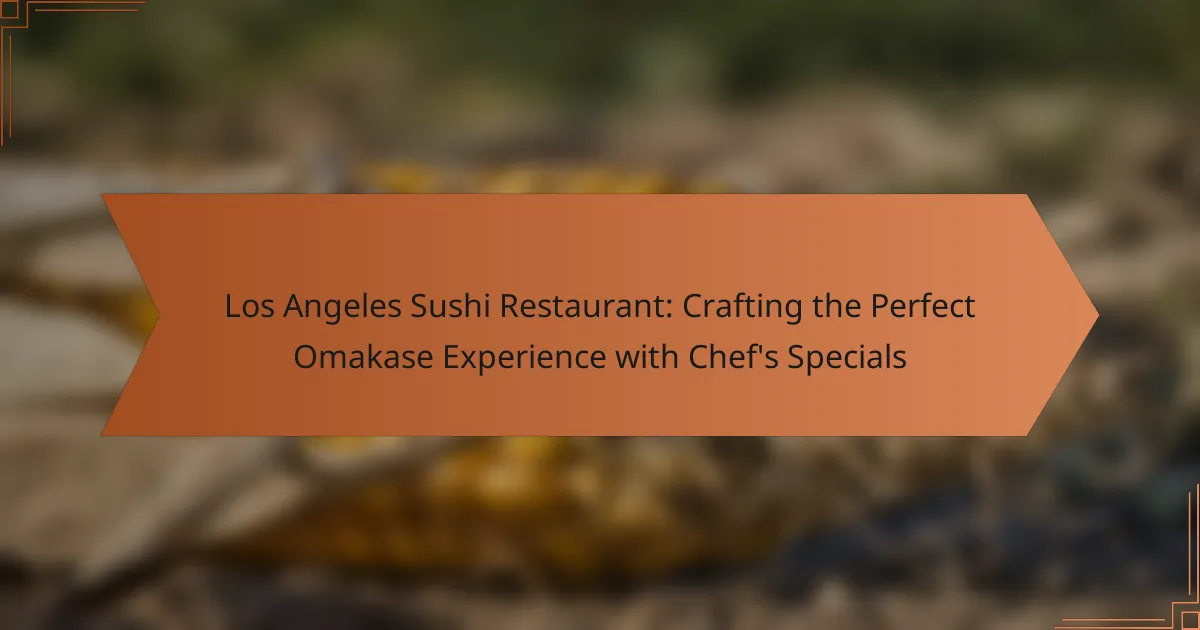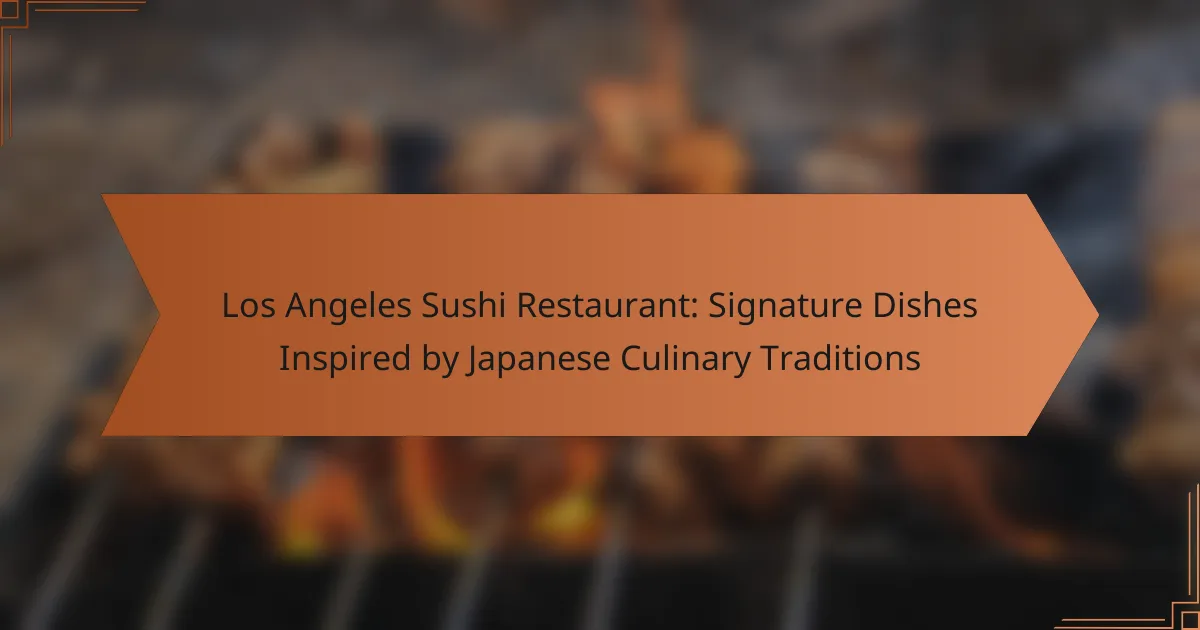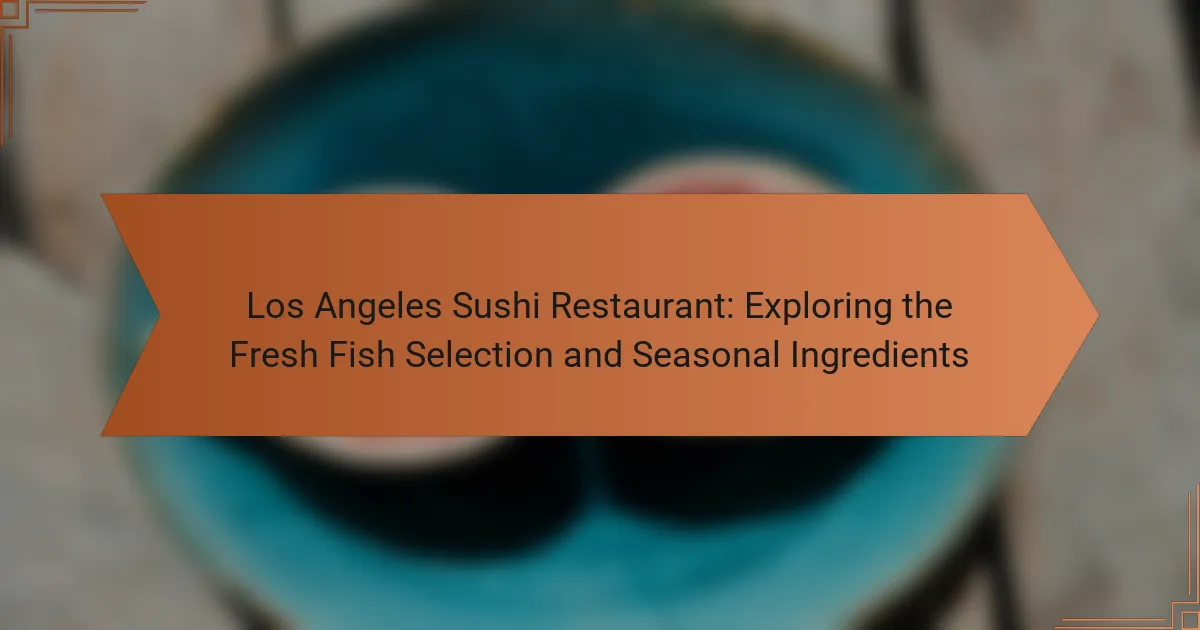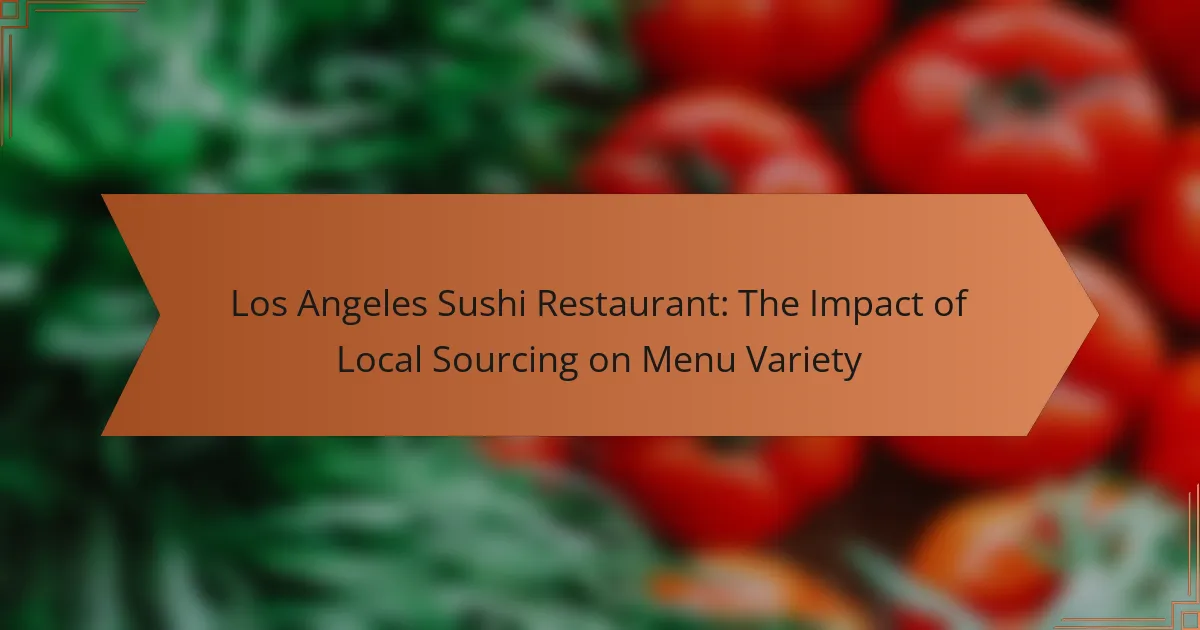Los Angeles sushi restaurants are characterized by their fusion of traditional Japanese techniques and modern culinary innovations. These establishments prioritize high-quality, fresh ingredients sourced from local markets and sustainable fisheries, offering a diverse menu that includes classic sushi rolls, sashimi, and unique fusion dishes. The ambiance typically reflects a blend of contemporary design and Japanese aesthetics, often featuring an omakase experience where chefs create personalized tasting menus. The city’s vibrant sushi culture is supported by a significant Japanese community and a climate conducive to year-round seafood availability, making Los Angeles a prominent hub for sushi dining in the United States. To fully appreciate sushi in this city, diners are encouraged to seek out reputable restaurants, observe skilled chefs, and consider traditional dining etiquette.

What defines a Los Angeles sushi restaurant?
A Los Angeles sushi restaurant is defined by its blend of traditional Japanese techniques and innovative culinary twists. These establishments often emphasize fresh, high-quality ingredients sourced from local markets and sustainable fisheries. Many Los Angeles sushi restaurants feature a diverse menu that includes classic sushi rolls, sashimi, and unique fusion creations. The ambiance typically combines modern design elements with a nod to Japanese aesthetics. Additionally, these restaurants frequently offer an omakase experience, where chefs curate a personalized tasting menu. This approach reflects the city’s multicultural influences and the evolving nature of sushi cuisine. Overall, Los Angeles sushi restaurants stand out for their creativity and commitment to quality.
How do traditional sushi techniques influence Los Angeles sushi restaurants?
Traditional sushi techniques significantly influence Los Angeles sushi restaurants by shaping their culinary practices and presentation styles. These techniques emphasize precision in rice preparation, fish selection, and knife skills. Many chefs in Los Angeles undergo training in Japan to master these skills. The use of high-quality, fresh ingredients is a hallmark of traditional sushi that is mirrored in local establishments. Additionally, the art of sushi-making is respected, with many restaurants showcasing the craftsmanship involved. This adherence to tradition enhances authenticity, attracting sushi enthusiasts. The balance of flavors and textures, a core principle of traditional sushi, is also a focus in Los Angeles menus. Overall, traditional techniques serve as a foundation while allowing for modern interpretations and fusion elements.
What are the key traditional techniques used in sushi preparation?
Key traditional techniques used in sushi preparation include rice seasoning, fish slicing, and rolling. Rice seasoning involves mixing cooked rice with vinegar, sugar, and salt to achieve the desired flavor. Fish slicing, known as “sukiyaki,” requires precise cuts to enhance texture and presentation. Rolling, or “makizushi,” involves placing ingredients on rice and rolling them in seaweed. Each technique has historical significance and contributes to authentic sushi preparation. Mastery of these techniques is essential for achieving the balance of flavors and aesthetics that define traditional sushi.
How do these techniques impact the flavor and presentation of sushi?
Traditional and modern sushi techniques significantly influence both flavor and presentation. Techniques such as rice preparation, fish selection, and cutting styles enhance the overall taste. Properly seasoned sushi rice provides a foundational flavor that complements the fish. The freshness and quality of the fish directly affect its taste and texture. Techniques like slicing fish at specific angles create a more appealing presentation. Artistic plating enhances visual appeal, making sushi more enticing. Use of garnishes adds color and flavor contrasts. Overall, these techniques create a harmonious balance of taste and aesthetics in sushi.
What modern twists are being incorporated into sushi in Los Angeles?
Modern twists in sushi in Los Angeles include innovative flavor combinations and unique presentations. Chefs are experimenting with ingredients like truffle oil and spicy tuna tartare. Sushi burritos have gained popularity, offering a fusion of sushi and Mexican cuisine. Plant-based options are also emerging, catering to vegan diets with ingredients like avocado and tofu. Sushi donuts are a creative twist, shaping sushi into donut forms. Additionally, there are sushi bowls that provide a deconstructed approach, allowing for customization. These trends reflect the city’s diverse culinary influences and the willingness to adapt traditional sushi.
How do chefs blend traditional and modern styles in their sushi creations?
Chefs blend traditional and modern styles in their sushi creations by incorporating innovative ingredients and techniques. They often use traditional sushi methods, such as vinegared rice and fresh fish, as a foundation. Modern influences may include fusion flavors and non-traditional toppings. For instance, chefs might add avocado or spicy sauces, which are not part of classic sushi. Presentation also evolves with modern aesthetics, emphasizing visual appeal. Some chefs experiment with cooking methods, like grilling or searing fish, to enhance flavors. This blend reflects cultural diversity and culinary experimentation in Los Angeles sushi restaurants. The result is a unique dining experience that honors tradition while embracing modernity.
What are some popular modern sushi dishes found in Los Angeles?
Popular modern sushi dishes in Los Angeles include sushi burritos, poke bowls, and sushi tacos. Sushi burritos combine sushi ingredients in a large wrap. Poke bowls feature marinated raw fish over rice with various toppings. Sushi tacos use seaweed shells filled with sushi fillings. These dishes reflect a fusion of traditional sushi with contemporary culinary trends. They cater to diverse tastes and preferences in the city. Many restaurants in Los Angeles offer these innovative dishes, making them widely accessible.

Why is Los Angeles a hub for sushi culture?
Los Angeles is a hub for sushi culture due to its diverse population and culinary innovation. The city has a significant Japanese community that has contributed to authentic sushi traditions. Additionally, Los Angeles offers a fusion of flavors, blending traditional sushi with local ingredients. The climate supports year-round seafood availability, enhancing freshness. The city hosts numerous sushi restaurants, ranging from casual to high-end dining experiences. Events like sushi festivals further promote the culture. According to a 2020 report, Los Angeles ranks among the top cities in the U.S. for sushi consumption. This combination of factors solidifies its status as a sushi epicenter.
What factors contribute to the popularity of sushi in Los Angeles?
Sushi’s popularity in Los Angeles is driven by diverse culinary influences and a health-conscious culture. The city’s multicultural environment fosters a variety of sushi styles. Many residents seek fresh, high-quality ingredients, which sushi provides. Additionally, sushi aligns with health trends emphasizing lean proteins and low-calorie meals. The rise of social media has also amplified sushi’s appeal, showcasing visually appealing dishes. Numerous sushi restaurants cater to different tastes, enhancing accessibility. Events and festivals celebrating Japanese cuisine further promote sushi culture in the region. The combination of these factors creates a thriving sushi scene in Los Angeles.
How does the diversity of Los Angeles influence sushi offerings?
The diversity of Los Angeles significantly influences sushi offerings. This city is home to a wide array of cultures and culinary traditions. As a result, sushi restaurants often incorporate unique ingredients and techniques from various ethnic cuisines. For example, fusion sushi rolls may blend traditional Japanese elements with flavors from Mexican or Korean dishes.
Additionally, the availability of fresh and diverse seafood options in Los Angeles enhances sushi quality. Local markets provide access to both traditional fish and exotic varieties. The city’s multicultural environment encourages chefs to experiment with innovative presentations and flavor combinations. This leads to a dynamic sushi scene that reflects the city’s rich cultural tapestry.
Ultimately, the diversity of Los Angeles contributes to a vibrant and evolving sushi culture that attracts both locals and tourists.
What role do local ingredients play in shaping sushi menus?
Local ingredients significantly influence sushi menus by enhancing flavor and freshness. Sushi chefs in Los Angeles often incorporate locally sourced seafood, vegetables, and herbs. This practice ensures the use of ingredients that are in season and readily available. For instance, local fish varieties like California yellowtail or rock cod may replace traditional Japanese fish. The use of local produce, such as avocados or citrus, adds unique flavors to sushi creations. Moreover, these ingredients reflect the regional culinary landscape and consumer preferences. By integrating local elements, sushi menus become more innovative and diverse. This approach also supports local economies and promotes sustainability in food sourcing.
How do sushi restaurants in Los Angeles differentiate themselves?
Sushi restaurants in Los Angeles differentiate themselves through unique menu offerings, ambiance, and culinary techniques. Many establishments focus on sourcing high-quality, sustainable seafood. Others incorporate fusion elements, blending traditional sushi with local ingredients. Some restaurants emphasize an omakase experience, showcasing chef-selected dishes. Ambiance also plays a crucial role, with varying themes from minimalist to vibrant decor. Additionally, innovative presentation styles set certain restaurants apart visually. Customer service quality can further enhance the dining experience. According to a 2022 survey, 70% of diners prefer restaurants that offer unique culinary experiences.
What unique dining experiences do these restaurants provide?
Los Angeles sushi restaurants provide unique dining experiences through innovative presentations and interactive elements. Many establishments offer omakase, where chefs curate a personalized tasting menu. This approach allows diners to enjoy seasonal ingredients and chef specialties. Some restaurants feature sushi-making classes, engaging patrons in the culinary process. Others incorporate themed decor or immersive atmospheres, enhancing the dining experience. Many venues also focus on sustainability, sourcing fish responsibly to promote eco-friendly practices. These unique aspects elevate the traditional sushi dining experience, making it memorable and distinct in Los Angeles.
How do customer preferences shape the evolution of sushi offerings?
Customer preferences significantly influence the evolution of sushi offerings. As diners express interest in diverse flavors and ingredients, sushi chefs adapt their menus accordingly. The rise of health-conscious eating has led to increased demand for vegetarian and vegan sushi options. Additionally, the popularity of fusion cuisine encourages the incorporation of non-traditional ingredients like mango and spicy sauces. Trends in sustainability also drive restaurants to source fish responsibly, aligning with consumer values. Market research indicates that restaurants offering customizable sushi options attract more customers. Consequently, sushi offerings continuously evolve to meet changing tastes and dietary preferences.

What are the best practices for enjoying sushi in Los Angeles?
To enjoy sushi in Los Angeles, choose a reputable sushi restaurant known for quality ingredients. Look for establishments that prioritize freshness, as sushi is best when made with the freshest fish. Observe the sushi chef’s technique; skilled chefs often showcase traditional methods. Consider trying omakase, where the chef selects the dishes for you, providing an authentic experience. Pair sushi with appropriate beverages, such as sake or green tea, to enhance flavors. Use soy sauce sparingly, as excessive amounts can mask the taste of the fish. Finally, eat sushi with your hands or chopsticks, following the cultural etiquette. These practices enhance the overall sushi experience in Los Angeles.
How can diners choose the right sushi restaurant in Los Angeles?
Diners can choose the right sushi restaurant in Los Angeles by considering quality, authenticity, and reviews. Quality is determined by the freshness of ingredients and the skill of the chef. Authenticity can be assessed through the restaurant’s adherence to traditional sushi-making techniques. Reviews from reputable sources and customer feedback provide insights into the dining experience. Checking for certifications or accolades can also indicate a restaurant’s credibility. Additionally, exploring the menu for a variety of sushi options can help diners gauge the restaurant’s expertise.
What are the essential factors to consider when selecting a sushi restaurant?
The essential factors to consider when selecting a sushi restaurant include the quality of ingredients, the skill of the chef, and the restaurant’s reputation. Freshness of fish is vital for sushi; high-quality restaurants source fish daily. The chef’s experience and training impact the preparation and presentation of sushi. A reputable restaurant often has positive reviews and recommendations from customers. Additionally, the ambiance and cleanliness of the establishment contribute to the overall dining experience. Price points should align with the quality offered, ensuring value for money. Lastly, menu variety can indicate the chef’s creativity and expertise in sushi-making.
How can diners identify quality sushi and authentic experiences?
Diners can identify quality sushi and authentic experiences by observing freshness, presentation, and chef expertise. Freshness is crucial; high-quality sushi uses fish caught within the last 24 hours. The fish should have a vibrant color and a clean, oceanic smell. Presentation matters; authentic sushi is artfully arranged, showcasing attention to detail.
Chef expertise is evident in the sushi-making process. A skilled chef demonstrates precise knife techniques and proper rice preparation. Diners can also inquire about the sourcing of ingredients. Restaurants that prioritize local or sustainably sourced fish often provide a more authentic experience.
Furthermore, traditional sushi restaurants may offer a limited menu, focusing on quality over quantity. This approach often reflects the chef’s mastery of specific dishes. Lastly, diners should pay attention to the ambiance. Authentic sushi restaurants often maintain a minimalist design, reflecting Japanese aesthetics.
What tips can enhance the sushi dining experience?
To enhance the sushi dining experience, choose a reputable sushi restaurant known for quality ingredients. Freshness is key; sushi should be made with fish that has been caught recently. Opt for seasonal ingredients to enjoy the best flavors. Pair sushi with appropriate beverages, such as sake or green tea, to complement the meal. Use soy sauce sparingly to avoid overpowering the delicate flavors of the fish. Try different types of sushi, such as nigiri, sashimi, and rolls, to explore a variety of textures and tastes. Engage with the sushi chef if possible; they can provide insights into the dishes and preparation methods. Lastly, enjoy the sushi at a leisurely pace to fully appreciate the craftsmanship involved.
How should one properly taste and appreciate sushi flavors?
To properly taste and appreciate sushi flavors, one should follow specific steps. Begin by observing the sushi’s presentation. The visual appeal can enhance the tasting experience. Next, use chopsticks or fingers to pick up a piece of sushi. This ensures a proper grip and respect for the food.
Before tasting, take a moment to inhale the aroma. Smelling the sushi can prepare your palate for the flavors. Then, take a small bite. Allow the sushi to rest on your tongue. This helps to identify the various flavors.
Chew slowly to experience the textures. Sushi often combines soft fish with firm rice. Notice the balance of flavors in each bite. Pay attention to the subtle nuances, such as sweetness or umami.
If soy sauce is available, dip the fish side lightly. Avoid soaking the rice, as it can overpower the flavor. For additional flavor, add a small amount of wasabi. This enhances the experience without overwhelming it.
Finally, cleanse your palate with pickled ginger between different pieces. This prepares your taste buds for new flavors. Following these steps allows for a deeper appreciation of sushi’s complexity and artistry.
What etiquette should be followed when dining at a sushi restaurant?
When dining at a sushi restaurant, proper etiquette enhances the experience. First, greet the sushi chef with a polite “Irasshaimase,” meaning “welcome.” Use chopsticks to eat sushi, but do not stick them upright in rice, as this resembles a funeral offering. It is appropriate to dip sushi fish-side down into soy sauce, preserving the rice’s integrity. Avoid mixing wasabi into soy sauce; instead, apply it directly to the sushi. Eating sushi in one bite is preferred, showcasing respect for the chef’s craftsmanship. Additionally, refrain from talking loudly to maintain a serene atmosphere. Lastly, express gratitude to the chef with a “gochisousama deshita” after finishing the meal, acknowledging their effort. Following these guidelines respects tradition and enhances the dining experience.
Los Angeles sushi restaurants are characterized by a fusion of traditional Japanese techniques and modern culinary innovations, emphasizing fresh, high-quality ingredients. The article explores how traditional practices influence flavor and presentation, while also highlighting contemporary trends such as sushi burritos and plant-based options. It discusses the impact of Los Angeles’ diverse culinary landscape on sushi offerings, the significance of local ingredients, and the unique dining experiences provided by these establishments. Additionally, it outlines best practices for enjoying sushi, etiquette to follow, and factors to consider when selecting a sushi restaurant.



